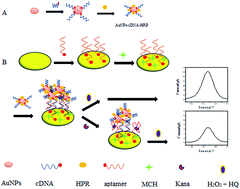Highly sensitive voltammetric determination of kanamycin based on aptamer sensor for signal amplification
Abstract
In this paper, a novel aptamer sensor for kanamycin was prepared by using a complementary DNA (cDNA) strand of kanamycin aptamer as sensor and horseradish peroxidase (HRP) as a biocatalyst for signal amplification. Gold nanoparticles (AuNPs) and HRP–AuNP–cDNA conjugates were prepared. Transmission electron microscope (TEM) images and ultraviolet-visible absorption spectra were used to characterize the AuNPs. After the cDNA in the conjugates hybridized with kanamycin aptamers immobilized on a gold electrode though Au–thiol interactions, hydroquinone (HQ) and H2O2 in solution were catalyzed by HRP to generate a voltammetric peak current signal. In the presence of kanamycin, aptamers bind with kanamycin to produce a complex on the surface of the gold electrode. The HRP–AuNP–cDNA conjugates therefore fall off from the electrode surface, and the voltammetric signal decreases. The aptamer sensor was successfully applied to determine kanamycin by differential pulse voltammetry (DPV). Under the optimal conditions, the cathodic peak current highly and linearly increased with kanamycin concentrations over the range of 0.010 to 150 μg L−1, with a detection limit of 0.005 μg L−1. This aptamer sensor was applied in the determination of kanamycin in milk with high specificity, sensitivity and selectivity.


 Please wait while we load your content...
Please wait while we load your content...